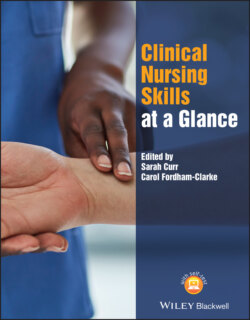Читать книгу Clinical Nursing Skills at a Glance - Группа авторов - Страница 20
Оглавление9 Moving and handling
Figure 9.1 Sit to stand.
Figure 9.2 Walking with assistance of one.
Figure 9.3 Walking with assistance of two.
Table 9.1 Using TILEO for safety in manual handling.
Source: Based on Smith 2011.
| Task | Does the task include twisting, stooping, bending, pushing, pulling, or sudden movement? |
| Individual | Consider the patient and the handler with respect to health, e.g. disability, pregnancy |
| Load | Consider weight, stability, ability to grip |
| Environment | Consider space constraints, flooring – stable, same level, hot/cold conditions |
| Other factors | Is the movement hindered by infusions, traction, drains? Have you the correct working equipment? |
Figure 9.4 Walking with a frame.
Figure 9.5 Standing to sitting.
Background
Moving and handling (MH) refers to the assistance given to a load1 to enable it to move.
These include lifting, putting down, pulling, pushing, carrying, supporting a load whilst static, throwing or moving by hand or bodily force.
MH is governed by the Health and Safety at Work Act 1974 and welfare legislation (National Back Exchange 2010), which include regulations for employers and employees to understand, and subsequently follow, to ensure their own and others’ safety.
MH procedures are often utilised in healthcare settings when assisting a patient with their mobility but can be applied to any environment where the MH of a load is required, e.g. supermarkets, warehouses, and mechanics’ garages.
MH is often required to maintain the safety of the patient but in undertaking these procedures healthcare providers need to ensure their own safety.
Back and musculoskeletal injuries are one of the most common causes of sick leave among healthcare professionals (HSE 2015). These are often a result of poor MH techniques.
Influencing Factors
Mobility and assistance requirements can change daily and thus a discussion with the patient on how much they feel able to do is required before supporting with any activity.
Changes in ability to mobilise should be documented when they occur. It could be that the patient has become more unwell, has increased pain, or requires bed rest post‐procedure.
Procedure – Key Points to Remember
Avoid
Performing any MH procedures.
Can the patient move themselves with direction?
Is there equipment that can be used?
Assess and Plan
It is essential to assess and plan before any MH procedures.
The acronym TILEO (task, individual, load, environment, other) can be used (Table 9.1; Smith 2011).
Spine in Line
Keep the spine's natural position to reduce any injury or damage while providing ease of movement.
Load Close
Keep the load close to your body as this reduces pressure on the lower back and provides ease of movement.
Stable Base, Soft knees
Provides ease of movement in a safe way.
Centre of Gravity
Should be neutral for safety.
Professional Approach
Obtain informed consent.
Provide reassurance.
Ensure effective teamwork and communication between all involved, including the patient.
Maintain privacy and dignity.
Work within your sphere of competence.
Moving and Handling Techniques
The following techniques are commonly used in healthcare settings when a person requires assistance with mobility. The techniques vary from minimal assistance to full assistance with the aid of MH equipment.
Sit to Stand
This method can be used when assisting a patient from a sitting to a standing position if safe, independent, mobilisation is not possible (Figure 9.1).
Before starting the process, establish if the person will be able to stand. For a patient to be able to stand, they need good core muscles as well as strength in their arms and legs.
Walking with Assistance of One
Once the person is standing, stand slightly behind but close to the person requiring assistance. Walk with your hands in a palm‐to‐palm hold (Figure 9.2).
Ask the patient to look in the direction they are wanting to walk in and let them initiate the first step.
Walk with the patient and provide reassurance.
Walking with Assistance of Two
Follow the above steps, with the second handler doing the same on the patient's other side.
Ensure both handlers' arms cross over, across the back of the patient, to provide further support (Figure 9.3).
Walking with a Frame
Inform the patient that once they are standing the frame will be placed within reach.
The patient's hands should be placed either side of the frame for support while they walk.
The frame should be moved first, followed by the patient's feet (Figure 9.4).
Standing to Sitting
Ensure the back of the patient's legs are touching the chair.
The patient reaches for the chair behind them with bottom out towards the chair to sit.
Your hand can come to the middle of their back and apply gentle pressure to guide the patient back into the chair (Figure 9.5).
Red Flags
Never use a frame to assist standing.
Do not walk too close to the patient’s hips; allow for natural sway and movement of hips.
Changes in mobility, particularly any weakness, should be noted and escalated as appropriate.
References
1 Health and Safety Executive (HSE) (2015) Health and Safety in the Health and Social Care Sector in Great Britain, 2014/15. www.hse.gov.uk/statistics/industry/healthservices/health.
2 Smith, J. (2011). The Guide to the Handling of People, 6e. London: National Back Pain Association.
3 The National Back Exchange (2010). Guidelines for Manual Handling, 3e. Towcester: The National Back Exchange.
Note
1 1 A load refers to a person or any object.
